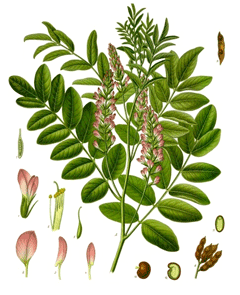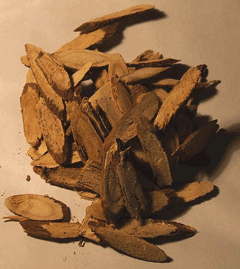 |
|
http://commons.wikimedia.org/wiki/File:Koeh-207.jpg |
 |
| http://en.wikipedia.org/wiki/User:Chameleon |
Translate this page:
Summary
Physical Characteristics

 Glycyrrhiza glabra is a PERENNIAL growing to 1.2 m (4ft) by 1 m (3ft 3in).
Glycyrrhiza glabra is a PERENNIAL growing to 1.2 m (4ft) by 1 m (3ft 3in).
See above for USDA hardiness. It is hardy to UK zone 8. It is in flower from June to July. The species is hermaphrodite (has both male and female organs) and is pollinated by Insects.
It can fix Nitrogen.
Suitable for: light (sandy) and medium (loamy) soils. Suitable pH: mildly acid, neutral and basic (mildly alkaline) soils. It can grow in semi-shade (light woodland) or no shade. It prefers moist soil. The plant can tolerates strong winds but not maritime exposure.
UK Hardiness Map
US Hardiness Map
Synonyms
Glycyrrhiza glandulifera. Glycyrrhiza hirsuta. Glycyrrhiza pallida. Glycyrrhiza violacea.
Plant Habitats
Cultivated Beds;
Edible Uses
Edible Parts: Root
Edible Uses: Sweetener Tea
Root - raw or used as a flavouring. The source of liquorice powder that is extracted and used in sweets, baked goods, ice cream, soft drinks etc[7, 34, 100, 183], it is also used medicinally. A sweet and delicious flavour, but the root is very fibrous[K]. The root contains glycyrrhizin, a substance that is 50 times sweeter than sucrose[171, 183, 238]. The dried root is often used for chewing, it is excellent for teething children and also as a tooth cleaner[7, 34]. A tea made from the roots is an excellent thirst quencher[21]. The powdered root is also used as a sweetener in other herb teas[183]. The leaves are used as a tea substitute in Mongolia[183].
References More on Edible Uses
Medicinal Uses
Plants For A Future can not take any responsibility for any adverse effects from the use of plants. Always seek advice from a professional before using a plant medicinally.
Alterative Antiinflammatory Antispasmodic Demulcent Diuretic Eczema Emollient Expectorant
Laxative Miscellany Pectoral Tonic Urinary
Liquorice his one of the most commonly used herbs in Western herbal medicine and has a very long history of use, both as a medicine and also as a flavouring to disguise the unpleasant flavour of other medications[4]. It is a very sweet, moist, soothing herb that detoxifies and protects the liver[238] and is also powerfully anti-inflammatory, being used in conditions as varied as arthritis and mouth ulcers[254]. The root is alterative, antispasmodic, demulcent, diuretic, emollient, expectorant, laxative, moderately pectoral and tonic[4, 9, 21, 46, 165, 178]. The root has also been shown to have a hormonal effect similar to the ovarian hormone[7]. Liquorice root is much used in cough medicines and also in the treatment of catarrhal infections of the urinary tract[4]. It is taken internally in the treatment of Addison's disease, asthma, bronchitis, coughs, peptic ulcer, arthritis, allergic complaints and following steroidal therapy[238]. It should be used in moderation and should not be prescribed for pregnant women or people with high blood pressure, kidney disease or taking digoxin-based medication[238]. Prolonged usage raises the blood pressure and causes water retention[7, 238]. See also the notes above on toxicity. Externally, the root is used in the treatment of herpes, eczema and shingles[238]. The root is harvested in the autumn when 3 - 4 years old and is dried for later use[4, 238]. The German Commission E Monographs, a therapeutic guide to herbal medicine, approve Glycyrrhiza glabra for coughs/bronchitis, gastritis (see [302] for critics of commission E).
References More on Medicinal Uses
The Bookshop: Edible Plant Books
Our Latest books on Perennial Plants For Food Forests and Permaculture Gardens in paperback or digital formats.

Edible Tropical Plants
Food Forest Plants for Hotter Conditions: 250+ Plants For Tropical Food Forests & Permaculture Gardens.
More

Edible Temperate Plants
Plants for Your Food Forest: 500 Plants for Temperate Food Forests & Permaculture Gardens.
More

More Books
PFAF have eight books available in paperback and digital formats. Browse the shop for more information.
Shop Now
Other Uses
Fibre Miscellany
The plant yields a substance that is used for etching steel sections in photomicrographic work[171]. Extracts from the root are used as a foaming agent in beers and fire extinguishers[238]. A fibre obtained from the roots is used for insulation, wallboard, boxboard etc[4, 171]. The fibres can be used after the medicinal and flavouring constituents of the root have been removed[4]. A dynamic accumulator gathering minerals or nutrients from the soil and storing them in a more bioavailable form - used as fertilizer or to improve mulch.
Special Uses
Dynamic accumulator Food Forest Nitrogen Fixer Scented Plants
References More on Other Uses
Cultivation details
Requires a deep well cultivated fertile moisture-retentive soil for good root production[200]. Prefers a sandy soil with abundant moisture and does not flourish in clay[4]. Slightly alkaline conditions produce the best plants[238]. The plant thrives in a maritime climate[7]. Plants are hardy to about -15°c[200]. Liquorice is often cultivated for its edible root which is widely used in medicine and as a flavouring. There are some named varieties[183]. The ssp. glandulifera grows in Russia and produces adventitious roots up to 10 cm thick[142]. Yields of 10 - 12 tonnes per hectare were considered good in the early 20th century, this only being attained in the fourth year of growth[4]. Unless seed is required, the plant is usually prevented from flowering so that it puts more energy into producing good quality roots[238]. The bruised root has a characteristic sweet pungent smell[245]. Plants are slow to settle in and do not produce much growth in their first two years after being moved[4]. The young growth is also very susceptible to damage by slugs and so the plant will require some protection for its first few years[K]. A fairly deep-rooting plant, the roots are up to 120cm long[4]. It can be difficult to eradicate once it is established[238]. This species has a symbiotic relationship with certain soil bacteria, these bacteria form nodules on the roots and fix atmospheric nitrogen. Some of this nitrogen is utilized by the growing plant but some can also be used by other plants growing nearby[200]. The plant is heat tolerant in zones 12 through 10. (Plant Hardiness Zones show how well plants withstand cold winter temperatures.
Plant Heat Zones show when plants would start suffering from the heat.
The Plant Heat Zone map is based on the number of "heat days" experienced in a given area where the temperature climbs to over 86 degrees F (30°C).
At this temperature, many plants begin to suffer physiological damage. Heat Zones range from 1 (no heat days) to 12 (210 or more heat days).
For example Heat Zone. 11-1 indicates that the plant is heat tolerant in zones 11 through 1.) For polyculture design as well as the above-ground architecture (form - tree, shrub etc. and size shown above) information on the habit and root pattern is also useful and given here if available. The plant growth habit is a runner spreading indefinitely by rhizomes or stolons [1-2]. The root pattern is stoloniferous rooting from creeping stems above the ground [1-2].
References Carbon Farming Information and Carbon Sequestration Information
Temperature Converter
Type a value in the Celsius field to convert the value to Fahrenheit:
Fahrenheit:
The PFAF Bookshop
Plants For A Future have a number of books available in paperback and digital form. Book titles include Edible Plants, Edible Perennials, Edible Trees,Edible Shrubs, Woodland Gardening, and Temperate Food Forest Plants. Our new book is Food Forest Plants For Hotter Conditions (Tropical and Sub-Tropical).
Shop Now
Plant Propagation
Pre-soak the seed for 24 hours in warm water and then sow spring or autumn in a greenhouse[200]. Prick out the seedlings into individual pots when they are large enough to handle, and grow them on for their first winter in a greenhouse. Plant out in late spring or early summer when in active growth. Plants are rather slow to grow from seed[238]. Division of the root in spring or autumn. Each division must have at least one growth bud. Autumn divisions can either be replanted immediately or stored in clamps until the spring and then be planted out[200]. It is best to pt up the smaller divisions and grow them on in a cold frame until they are established before planting them out in the spring or summer.
Other Names
If available other names are mentioned here
Native Range
TEMPERATE ASIA: Armenia, Azerbaijan, China, Ciscaucasia, Cyprus, Dagestan, Georgia, Iran, Iraq, Israel, Jordan, Kazakhstan, Kurganskaja oblast, Kyrgyzstan, Lebanon, Mongolia, Russian Federation, Russian Federation, Russian Federation-Ciscaucasia, Syria, Tajikistan, Turkey, Turkmenistan, Uzbekistan, Xinjiang Uygur Zizhiqu,Afghanistan. TROPICAL ASIA: India (northwest), Pakistan, EUROPE: Russian Federation-European part, European part, Moldova, Ukraine (incl. Krym), Former Yugoslavia, Albania, Bulgaria, Greece (incl. Crete), Italy (incl. Sardinia, Sicily), Romania, France, AFRICA: Libya (n.?).
Weed Potential
Right plant wrong place. We are currently updating this section.
Please note that a plant may be invasive in one area but may not in your area so it's worth checking.
Conservation Status
IUCN Red List of Threatened Plants Status :

Growth: S = slow M = medium F = fast. Soil: L = light (sandy) M = medium H = heavy (clay). pH: A = acid N = neutral B = basic (alkaline). Shade: F = full shade S = semi-shade N = no shade. Moisture: D = dry M = Moist We = wet Wa = water.
Now available:
Food Forest Plants for Mediterranean Conditions
350+ Perennial Plants For Mediterranean and Drier Food Forests and Permaculture Gardens.
[Paperback and eBook]
This is the third in Plants For A Future's series of plant guides for food forests tailored to
specific climate zones. Following volumes on temperate and tropical ecosystems, this book focuses
on species suited to Mediterranean conditions—regions with hot, dry summers and cool, wet winters,
often facing the added challenge of climate change.
Read More
Expert comment
Author
L.
Botanical References
50200
Links / References
For a list of references used on this page please go here
Readers comment